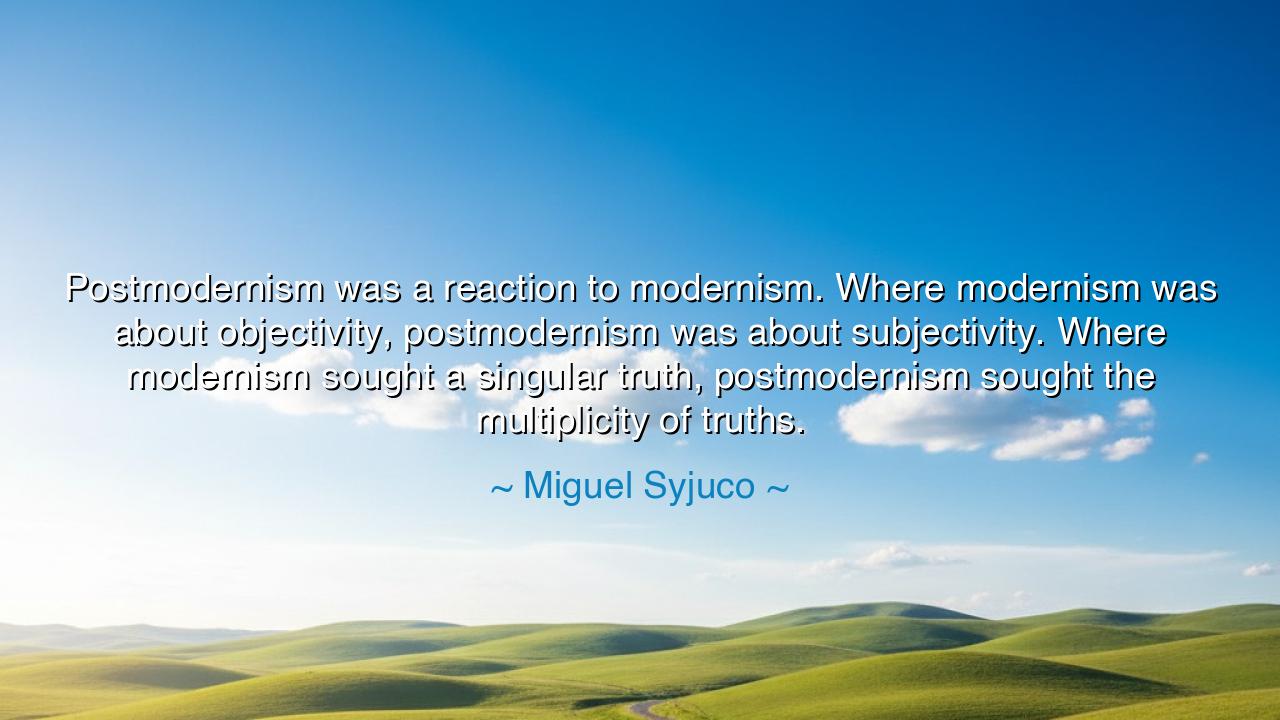
Postmodernism was a reaction to modernism. Where modernism was
Postmodernism was a reaction to modernism. Where modernism was about objectivity, postmodernism was about subjectivity. Where modernism sought a singular truth, postmodernism sought the multiplicity of truths.






The words of Miguel Syjuco—“Postmodernism was a reaction to modernism. Where modernism was about objectivity, postmodernism was about subjectivity. Where modernism sought a singular truth, postmodernism sought the multiplicity of truths.”—sound like the tolling of a great bell marking the turn of ages. In them, he captures the shift of thought that reshaped the art, philosophy, and culture of the twentieth century: the movement from the clean lines of modernism to the fractured mirrors of postmodernism. His words are not just an observation of history, but a lesson in how humanity’s understanding of truth evolves with the march of time.
The origin of this distinction lies in the upheavals of the nineteenth and twentieth centuries. Modernism arose in an age intoxicated by science, progress, and the belief that reason could reveal objective reality. The modernists sought clarity, order, and universal principles: in literature, in architecture, in philosophy. They believed in a singular truth, accessible to human reason, that could be articulated and built upon. Yet as the world descended into wars, as technology brought both marvels and horrors, faith in this certainty began to crumble. Out of this disillusionment came postmodernism, whispering: there is no single truth, but many; there is no fixed perspective, only shifting subjectivities.
The ancients, too, understood this tension. Plato sought the eternal Forms, unchanging realities behind the appearances of the world. Yet Protagoras declared, “Man is the measure of all things,” suggesting that truth varies with perception. This debate, reborn in modern and postmodern thought, reminds us that human culture always oscillates between the hunger for certainty and the acceptance of multiplicity. Syjuco’s words echo this timeless dance, reminding us that both objectivity and subjectivity are lenses through which we approach reality.
History offers vivid illustrations. Consider architecture: modernism gave us the clean, functional lines of Bauhaus buildings, structures that spoke of order, efficiency, and universality. But postmodernism rebelled, filling skylines with playful colors, irony, and pastiche, rejecting the singular vision in favor of many voices. The same can be seen in literature: James Joyce sought a universal epic in the modernist masterpiece Ulysses, while postmodernists like Thomas Pynchon reveled in fragmentation, multiplicity, and ambiguity. These shifts were not accidents, but reflections of how societies perceived truth itself.
Yet Syjuco’s words also bear a deeper message: that no single era holds the monopoly on wisdom. Modernism taught us the power of reason, the dignity of order, and the pursuit of universals. Postmodernism taught us humility, reminding us that human experience is diverse, fractured, and plural. Both reveal different facets of our existence. To cling only to one is to miss the fullness of truth. The singular and the multiple, the objective and the subjective, must be held in tension, like the strings of a lyre that together create harmony.
The danger lies in excess. To worship modernism alone is to become rigid, blind to the richness of perspective. To worship postmodernism alone is to dissolve into chaos, where nothing is certain and all dissolves into irony. The wise must learn from both: to value objectivity where it anchors us, but also to honor multiplicity where it expands us. Truth is both one and many, eternal and shifting, depending on how we gaze upon it.
Therefore, take this lesson: do not seek truth only in universals, nor only in fragments. When you build, build with clarity—but do not forget that others may see the world differently. When you listen, honor not just the facts, but the stories that give those facts meaning. In your life, walk as one who embraces both order and diversity, both certainty and humility. For as Miguel Syjuco reminds us, each age reveals a face of truth, and the whole of wisdom is found not in choosing one, but in holding the two in balance.






AAdministratorAdministrator
Welcome, honored guests. Please leave a comment, we will respond soon